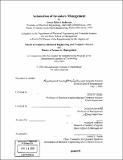Automation of inventory management
Author(s)
Anderson, James Robert, 1972-
DownloadFull printable version (11.58Mb)
Other Contributors
Leaders for Manufacturing Program.
Advisor
Alvin W. Drake and Nelson Repenning.
Terms of use
Metadata
Show full item recordAbstract
Qualcomm Wireless Business Solutions (QWBS) provides communication equipment and services used to track trucking fleets and other capital assets via satellite. Order fulfillment and inventory management practices in QWBS were non-uniform and manually intensive. Buyers used their own intuition and rules-of-thumb to decide how many parts to order and how many parts should be held in stock to buffer against unexpected demand fluctuations. Non-uniform, manual inventory management practices resulted in higher inventory levels, lower customer service, and higher operational costs than can be achieved with uniform, formal management practices. This thesis describes the design and implementation of an automated inventory management system that optimizes inventory levels and alleviates manual effort. Benchmarking was used to show how a similar firm used inventory management techniques to improve efficiency and reduce costs. Quantitative analysis was used to develop an inventory management simulator that allowed alternative management strategies to be tested before implementing changes to the real system. Simulation results showed that QWBS inventories for fiscal year 2001 (FY01) could have been reduced by 40% had an automated inventory management policy been in place. In addition, automation would have reduced the manual effort of buyers by about 32%. Results from the simulator motivated the formation of the Automated Inventory Manager (AIM) project team. AIM is designed to automate order fulfillment and inventory management tasks and allow procurement's human resources to be redirected from low level transaction processing tasks to more value-added tasks. AIM is expected to liberate $700K in working capital and save approximately $240K per year in ongoing inventory and labor cost reductions, representing a 1-year ROI of 200%. However, AIM represents only the first step in a recommended cost reduction program to streamline the fulfillment of customer orders and reduce organizational redundancies.
Description
Thesis (S.M.)--Massachusetts Institute of Technology, Sloan School of Management; and, (S.M.)--Massachusetts Institute of Technology, Dept. of Electrical Engineering and Computer Science; in conjunction with the Leaders for Manufacturing Program at MIT, 2002. Includes bibliographical references.
Date issued
2002Department
Leaders for Manufacturing Program at MIT; Massachusetts Institute of Technology. Department of Electrical Engineering and Computer Science; Sloan School of ManagementPublisher
Massachusetts Institute of Technology
Keywords
Sloan School of Management., Electrical Engineering and Computer Science., Leaders for Manufacturing Program.